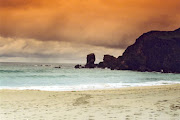Allt na Muilne was better known to us as Allt a'Ghearraidh and drained from the northern end of Loch Langavat,between Cnoc a' Choin and Skorashal Mor(in Garenin village)across the green pastures of the Gearraidh,finally descending rapidly to the sea at Geodha na Muilne,a little sandy bay,as treacherous as it is beautiful.In the 1800s,there were three "corn mills" driven by this one river,and each of these are now referred to as Norse-type mills(more on these later).The best preserved of these mills is the one below Cnoc a' Choin,lying just inside the "Garenin fence".The channel can still be seen,where the river would be diverted through the mill, to rotate the blades, attached to the shaft passing through the the large circular grinding stone.I should point out that,whereas this is what one would have seen about 20 years ago,today those two beautiful millstones are in a local museum about a mile away,and cost the curator £20,at that time.Still, you can probably imagine where the stones formerly were placed.These stones looked like a quartz granite,and were beautifully fashioned by an expert quarry man or a skilled stone mason.The square hole in the centre of the stone required to be chiseled out by someone of considerable expertise.My grandfather,Donald Macleod("Glass")who was born in Garenin in 1860, used this mill to grind corn for his family.The mill was communally owned by the Garenin people,and each family would be responsible for its upkeep and would have access for its use.Glass would come across from Garenin to the mill with a horse and cart,loaded with bags of oats,barley or corn,and he was allowed the whole day there.They came prepared with their own victuals,and hopefully before nightfall they were on their way home with bags filled with flour,barley meal or oatmeal.
The other two mills are very near the sea,and it is these that give the Allt and Geotha their name.They lie on that part of the river which descends rapidly to the sea.They are located one below the other at a distance of 20/30 yards apart and were possibly operated at the same time,using the same sluice. They are in a fairly ruinous condition and the millstones were probably removed when the people set up other mills.I don't think they're in the museum.In later times the proprietor set up large mills throughout the island,and tried to persuade the people to use these "super" mills,at quite a cost.The people were very reluctant to abandon their own mills,but pressure was brought to bear.
The "iolaire"(golden eagle)often builds its eyrie here in the Gearraidh or further round the coast towards Dalbeg or in the other direction towards Garenin.The eagles have been known to take newborn lambs,and this was definitely the opinion of my old friend Alexan an 'Illip(Alexander Maclennan),an intelligent and erudite man, blessed with tremendous recall,and a sense of humour,to boot.He,my mother,Anna Glass ,George Macleod((No.8 Dalmore)and a few others were those who enthused me with the the stories of long ago.
Always, on my first visit to see Alexan,when home on holiday,I would ask him if he seen the eagles this year.He was in the scullery boiling some water on the Calor ring,to make tea for us with a slice of sultana cake.He stopped what he was doing,and turning towards me he said."Do you know,Iain? If there are two things which I hate,it's the golden eagle,and that Rab.C.Nesbit !" Only Alexan could have juxtaposed that majestic bird and a wastrel in a string vest.
Dalmore Daytime

Sandy Beach
Wednesday, 30 January 2008
Subscribe to:
Post Comments (Atom)


No comments:
Post a Comment